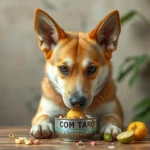
Introduction
Proper dog nutrition is critical for maintaining your furry friend’s overall health and well-being. Just like humans, dogs require a balanced diet to thrive, and understanding the intricacies of dog food measurements is essential. One common question that arises among dog owners is: how much does a cup of dog food weigh? This question is vital for ensuring that you are feeding your dog the correct portion size, which plays a significant role in their health.
In this article, we will delve into the importance of accurate dog food measurements, the weight of a cup of dog food, how this weight impacts dog nutrition, and practical tips for dog owners. By the end, you will have a comprehensive understanding of how to manage your dog’s diet effectively.
Understanding Dog Food Measurements
The Importance of Accurate Measurements
Accurate measurements are crucial when it comes to dog nutrition. Feeding your dog the right amount of food helps prevent obesity, malnutrition, and various health issues. Overfeeding can lead to obesity, which is associated with joint problems, diabetes, and other serious health concerns. Conversely, underfeeding can result in malnutrition, affecting your dog’s energy levels, coat condition, and overall health.
Common Units of Measurement in Dog Food
When measuring dog food, you will encounter several units of measurement, including:
- Cups: A standard unit for measuring dry dog food.
- Ounces: Often used for smaller portions.
- Grams: Commonly used in nutritional calculations.
- Pounds: Useful for bulk purchases.
Understanding the conversion between these measurements can help you better manage portion sizes. For instance, one cup of dry dog food typically weighs between 4 to 8 ounces, depending on the brand and type.
Weight of a Cup of Dog Food
Average Weight of Dog Food
The average weight of a cup of dog food can vary significantly based on several factors, including kibble size, density, and moisture content. Most dry dog foods weigh between 4 to 8 ounces per cup. For example, larger kibble pieces might weigh less than smaller, denser kibble, even if they occupy the same volume. Additionally, higher moisture content can also affect weight; however, most dry foods maintain a consistent moisture level.
Variability in Dog Food Brands
Different dog food brands and types exhibit variability in weight. For instance, a cup of grain-free dog food may weigh differently than a cup of grain-inclusive food due to their distinct nutrient compositions. Here’s a quick comparison:
| Dog Food Type | Average Weight (per cup) |
|---|---|
| Grain-free kibble | 4-6 ounces |
| Grain-inclusive kibble | 6-8 ounces |
| Wet food | N/A (measured in ounces) |
Understanding these differences can help you determine the appropriate portion sizes for your dog.
Measuring Dog Food Accurately
To ensure accurate measurements, consider the following techniques:
- Use a measuring cup: Always use a dry measuring cup specifically designed for solid ingredients.
- Kitchen scale: For the most accurate measurement, use a kitchen scale to weigh the food in grams or ounces.
- Check the serving size: Refer to the feeding guidelines provided by the dog food manufacturer, but adjust based on your dog’s specific needs and activity levels.
Impact of Dog Food Weight on Nutrition
Daily Caloric Needs
Understanding your dog’s daily caloric needs is vital in managing their weight and overall health. The caloric requirements vary based on factors such as age, size, breed, and activity level. To calculate your dog’s daily caloric needs, you can use the formula:
- For maintenance:
- Weight (in pounds) x 30 + 70 = Daily Calories
The weight of the dog food will influence how much you feed your dog to meet these caloric needs, making it crucial to know how much does a cup of dog food weigh.
Nutritional Balance
A balanced diet is essential for your dog’s health, which includes the right amounts of proteins, fats, and carbohydrates. The weight of the food you serve directly influences this balance. For example, if the food is dense in calories, a smaller portion may suffice, while low-calorie foods may require larger portions. Always aim for a food that meets your dog’s nutritional needs, and adjust the amount based on its weight.
Practical Tips for Dog Owners
Portion Control Strategies
Managing portion sizes effectively is crucial for your dog’s health. Here are some strategies:
- Use measuring tools: Regularly measure your dog’s food using a measuring cup or kitchen scale to ensure you’re giving the right amount.
- Regular weight checks: Weigh your dog periodically to monitor any changes in weight, and adjust food portions accordingly.
Adjusting Diet Based on Activity Level
Your dog’s activity level plays a significant role in determining their food intake. More active dogs may require higher calories, while less active dogs will need less. Tailor your dog’s daily portions based on their exercise habits to maintain a healthy weight.
Transitioning to New Dog Food
When transitioning your dog to a new food, it’s important to do so gradually. Sudden changes can cause digestive upset. Measure both the old and new food accurately during the transition, and monitor your dog’s weight and health closely during this period.
Common Myths About Dog Food Measurements
Misconceptions About Feeding Guidelines
Many dog owners believe that feeding guidelines on dog food packaging are one-size-fits-all. This is a common misconception. Each dog is unique, and factors such as age, weight, breed, and health conditions can significantly affect their dietary needs. Always consult your veterinarian for personalized advice.
The Role of Dog Size and Breed
Different breeds may require different measuring practices. For instance, smaller breeds may need higher-quality kibble with more concentrated nutrients, while larger breeds may benefit from larger kibble pieces that promote dental health. Tailoring the measurement and type of food based on breed can enhance overall nutrition.
Conclusion
Understanding how much does a cup of dog food weigh is essential for any responsible dog owner. Accurate measurements play a pivotal role in maintaining your dog’s health, preventing obesity, and ensuring a balanced diet. By applying the information covered in this article, you can make informed decisions regarding your dog’s nutrition, leading to a healthier, happier pet.
FAQs
How can I find out the weight of my specific brand of dog food?
Most dog food brands provide nutritional information and serving sizes on their packaging. You can also check the manufacturer’s website or contact their customer service for precise information.
What should I do if my dog is overweight?
If your dog is overweight, consult with your veterinarian for a tailored weight loss program. They may recommend reducing portion sizes, adjusting the type of food, and increasing exercise.
How do I know if I am feeding my dog the right amount?
Monitoring your dog’s weight, energy levels, and overall health will help determine if you are feeding the right amount. Regular consultations with your veterinarian can also provide valuable insights into your dog’s dietary needs.









